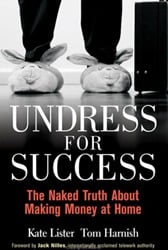Telecommuting And You
Section titles like ‘Expose Yourself — Are Your Right for E-work?’ or ‘Dirty Underwear — Uncovering the Scams’ do add an element of fun to what is essentially a book on changing your career. It is easy to read — the writing style reminds me of a blog. Each section is broken down into chapters, which are then subdivided into bite-sized pieces of information on specific topics. Even though the book is 262 pages, I was able to breeze through it, bookmarking sections I wanted to come back to later. The five primary sections of Undress for Success cover the basics of e-work (meaning work you can do from home over your computer), telecommuting, freelancing, running your own home business, and the appropriate technology. Far and away, the emphasis of the book is on telecommuting: that section racks up 114 pages. In comparison, freelancing gets just 38 pages. I wouldn’t really recommend the book as the introduction to all things freelance or entrepreneurial — but its coverage of telecommuting and teleworking is solid.
The Bare Bones of Working At Home
Lister and Harnish are careful to point out that working from home is not for everyone. They interviewed scores of folks who work at home, talking about the challenges they face and how they cope with them. My favorite was easily the approach one programmer named Madison takes to make sure her family knows when she’s on the job and has to focus on her work: “To make sure everyone knows when she isn’t available, she wears a tiara when she’s ‘at work.’” It’s hard to guess the coping mechanisms you’ll come up with when you’re working at home yourself, but the fact that Undress for Success actually gets its hands dirty with the various problems someone working at home faces certainly makes it a better resource. The book also includes several chapters on convincing an employer to let you make the switch to working at home — up to and including helping you outline the benefits that making the switch to telecommuting will bring to your employer. While we’ve discussed talking to your boss about telecommuting here recently, Lister and Harnish have the room to go into depth in covering that topic thoroughly. Another useful portion of the telecommuting section is the focused look at a number of careers that Undress for Success offers. Those include:
Call Center Agent Virtual Assistant Medical Transcriptionist Teacher or Tutor Remote Tech Writer Telemedicine
For each of those careers, there is a chapter covering what you can expect, training, scheduling, compensation and even stories from workers in the trenches. There’s even information on the scams in each career, equipping you to avoid them.
The Drawbacks to ‘Undress for Success’
While Lister and Harnish provide a solid reference on telecommuting, along information on handling issues like convincing your family that you’re actually at work even if you are still in your pajamas, I think that Undress for Success is missing something. That something is a discussion of other work-at-home options beyond telecommuting. The sections on freelancing and starting a home business are fairly bare bones — and since moving into freelancing is essentially creating a business, I don’t think that dividing the two into separate sections really helped. At best, Undress for Success offers just enough information on creating your own business to get you thinking, “Hm, I could do that.” If you were to decide to go that route based on this particular book, though, you’ll still find yourself looking for a lot of introductory level material. It is important to do plenty of research before embarking on any entrepreneurial venture, but I can’t help feeling that the book could have included a little more information on getting started. I know that Lister and Harnish have written about small business topics before — their first book was Finding Money: The Small Business Guide to Financing — perhaps they were able to go more in-depth on business topics there.
Readability and Moving Forward
Overall, I found Undress for Success very readable — and very interesting. It does overreach a bit, but if you’re looking for information on moving into telecommuting, this book is an ideal starting point. Furthermore, if you don’t have a lot of time to devote to sitting down and plowing through a book, the format works well: each section is just short enough that you can read one whenever you actually have a minute. In Undress for Success, Kate Lister and Tom Harnish have brought together an introductory guide to working at home that provides a starting point for readers to explore telecommuting and teleworking. You can find more information at their website, also named Undress for Success. If you’ve been considering making the switch to working at home, I’m interested in hearing what books, websites and other resources have helped you in the decision making process — no matter what option you wound up going with. I know that books like Tim Ferriss’ The 4-Hour Work Week have inspired more than a few people to explore telecommuting, but what else is out there. Please share your resources in the comments.
